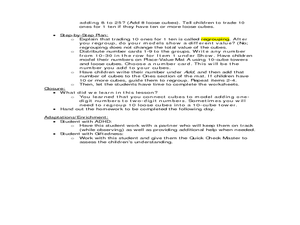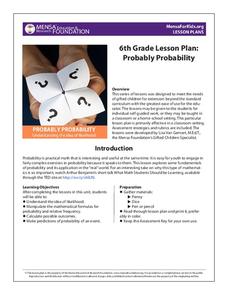Curated OER
Place Value
Students use various manipulatives and play a game to practice place value and to help them visually see how many "ten" is.
Curated OER
Title Balancing With Tidy Numbers
Young scholars use math manipulatives (ice block sticks) to show the addition of two 2-digit numbers. They discuss short-cuts that might be used to make the problem easier. they apply the same principle for adding larger numbers, as well.
Curated OER
Factoring Trinomials
Students factor trinomials using algebra tiles and blocks. In this algebra lesson plan, students complete a trinomials station activity. They work backwords to find their answers and discuss their steps in a group.
Curated OER
Regrouping Ten Ones for One Ten
Students explore regrouping. In this hands-on math place value lesson, students construct models using connecting cubes and place value mats to solve simple addition problems that require regrouping.
Curated OER
A Penny Saved is a Penny Earned
Students explore the concept of exponential growth. For this exponential growth lesson, students manipulate power models with base 2. Students discuss what would happen if you doubled a penny over the course of 20 days. ...
Curated OER
Exploration with Geometric Solids
Students reinforce geometric concepts by playing "Guess My Solid." Through a process of elimination, they determine the shapes of mystery solids. Finally, students use various materials to construct their own geometric figures.
Curated OER
Two Digit Addition with Regrouping
Students explore the concept of "regrouping." In this 2-digit addition with regrouping lesson, students create visual representations of combinations that equal ten using a tens frame. Students use manipulatives to represent the tens...
Curated OER
Powers of Ten
Pupils make paper ten strips using graph paper. They add them together to depict the powers of ten.
Curated OER
The 3R's: Rights, Rules, and Responsibilities
Eighth graders complete seven work stations that highlight math activities while they focus on the rules for Internet use and classroom rules for working in cooperative groups. After completing the activities, they complete a self-...
Curated OER
Area and Perimeter of Rectangles
Discover the difference between area and perimeter. Learners are grouped in twos and threes and each group has one advanced/gifted learner to serve as the peer helper. They receive manipulatives to help them determine the area and...
Curated OER
Getting to Base 10
Students compare and contrast number systems from around the world. They study the decimal system to design and create their own base 10 sticks. Afterward, they use base 10 sticks to solve various addition and subtraction problems.
EngageNY
Three-Dimensional Space
How do 2-D properties relate in 3-D? Lead the class in a discussion on how to draw and see relationships of lines and planes in three dimensions. The ability to see these relationships is critical to the further study of volume and...
Mathematics Assessment Project
Sorting Equations and Identities
Identify the identity. Learners first solve equations to find the number of solutions. Scholars then determine if given equations are always, sometimes, or never true, leading to the concept of identities.
MENSA Education & Research Foundation
Probably Probability
Reinforce the concept of probability with a series of lessons highlighting the idea of likelihood, probability formulas, relative frequency, outcomes, and event predictions. The collection is made up of four lessons offering informative...
Alabama Learning Exchange
Exponents and Division
Create a human fraction to learn about division of exponents. Scholars develop the rule for division of exponents by being part of a human fraction to explore and justify the rule. They also consider zero exponents and negative exponents.
West Contra Costa Unified School District
Adding by finding 10's
Count with ten frames in a first grade addition lesson. Kids determine how to identify numbers on a number line, as well as with ten frames, and complete ten frames to show their answers in several addition problems.
EngageNY
Types of Statistical Studies
All data is not created equal. Scholars examine the different types of studies and learn about the importance of randomization. They explore the meaning of causation and when it can be applied to data.
American Statistical Association
Exploring Geometric Probabilities with Buffon’s Coin Problem
Scholars create and perform experiments attempting to answer Buffon's Coin problem. They discover the relationships between geometry and probability, empirical and theoretical probabilities, and area of a circle and square.
Mathematics Assessment Project
Maximizing Area: Gold Rush
Presenting ... the gold standard for a lesson. Learners first investigate a task maximizing the area of a plot for gold prospecting. They then examine a set of sample student responses to evaluate their strengths and weaknesses.
Illustrative Mathematics
Placing a Fire Hydrant
Triangle centers and the segments that create them easily become an exercise in memorization, without the help of engaging applications like this instructional activity. Here the class investigates the measure of center that is...
Curated OER
Addition and Subtraction using Manipulatives
Sixth graders participate in a question and answer session to begin their understanding. Students complete a practice assignment using color counters. Students' assessment is composed of using color counters to complete an independent...
Curated OER
Math: Are They the Same - or Knot?
Students discover the equivalence between knots and math through a manipulative exploration. In pairs, they select three sets of identical knots and change their forms without breaking the knots apart. Students pass them along to the...
Curated OER
Kindergarten Math Counting
Young scholars practice their counting skills. In this counting practice lesson, students count from one to five orally, write the numbers through five independently, identify the numbers, and use macaroni for a hands on counting activity.
Curated OER
Using inverse Operations to Solve Equations
Fifth graders solve equations. In this algebraic equations lesson plan, 5th graders use the inverse operation to solve an equation. The teacher reminds students to perform the operation on both sides of the equation. This lesson plan...























